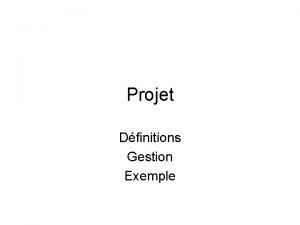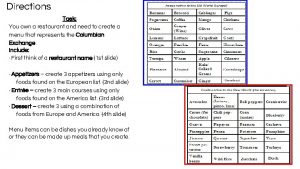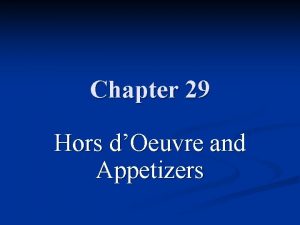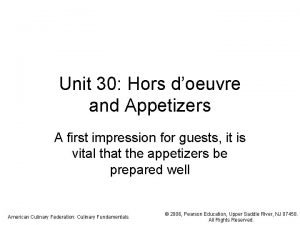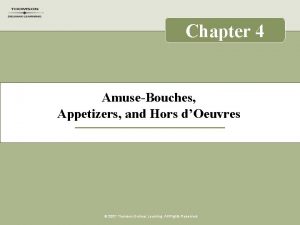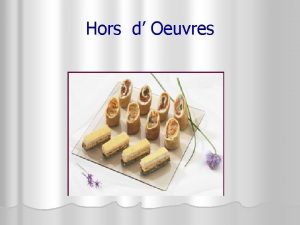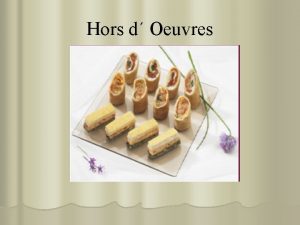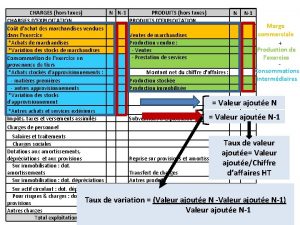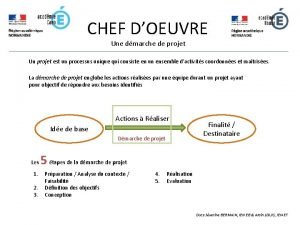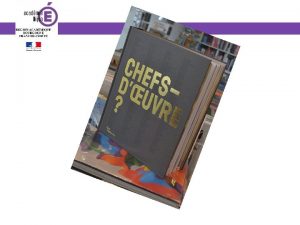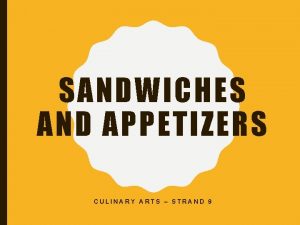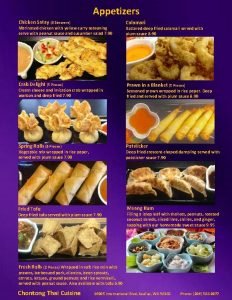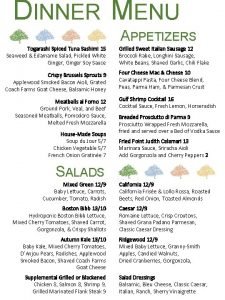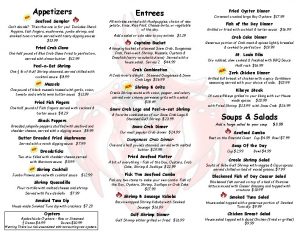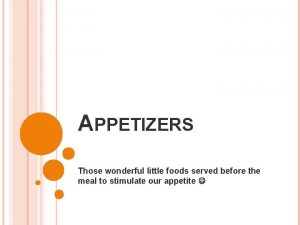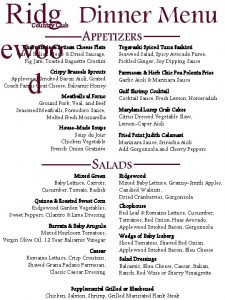Chapter 9 Appetizers and Hors doeuvre Chapter 9

























- Slides: 25

Chapter 9 Appetizers and Hors d’oeuvre

Chapter 9 Objectives • • Compare and contrast appetizers and hors d’oeuvre Identify composed hors d’oeuvre including canapés, profiteroles, tartlets, and barquettes Discuss the role of appetizers in à la carte, buffet, and tasting menu situations Explain how to select and prepare appetizers Recognize the principles of presenting appetizers Understand the preparation of cold savory mousses, sorbets, savory foams and encapsulations Understand how to serve caviar

Distinctions Between Appetizers and Hors d’oeuvre n n Hors d’oeuvre are typically served as preludes to a meal. Hors d’oeuvre are small bite-sized items. Appetizers are served as the first course of a meal. Typically, appetizers are small portions of very flavorful items, meant just to take enough edge off the appetite to permit thorough enjoyment of an entrée.

Hors d’oeuvre n n n Translates as “outside the work. ” Today it is increasingly common for clients to request an entire menu made up of hors d’oeuvre to serve at a reception or cocktail party as a “standing meal. ” There a few precepts to remember in general hors d’oeuvre preparation and presentation: n n Keep in mind the nature of the event, as well as the menu to follow. Ice carvings and ice beds are sometimes used to keep seafood and caviar very cold, as well as for their dramatic appeal. Hors d’oeuvre served on platters or passed on trays butler style should be thoughtfully presented. Choose something eye-catching that will show off the design of the hors d’oeuvre.

Composed Hors d’oeuvre n n Composed hors d’oeuvre are built from two or more components. Can be served as: n n n Tartlets Barquettes Canapés Profiteroles Spoons n Classic elements: n n n Cured and smoked foods Pâtés Foie gras Salads Vegetables Mousse

Barquettes and Tartlets n n Pâté dough can be used to create small edible containers, known as barquettes or tartlets. They may be filled with a cold mousse or other savory fillings. Very moist fillings can quickly make the pastry shell soggy. These hors d’oeuvre are best when assembled as close as possible to service time.

Barquettes and Tartlets n Some classic examples from around the world: n n n Bouchées Empanadas Beurrecks and tiropettes Dim sum Spring rolls

Canapés n n Canapés are small open-faced sandwiches. Elements of canapés: n n Small piece of bread cut to shape and toasted Spread Filling or topping Garnish

Profiteroles n n Profiteroles are small, round, hollow puffs made from pâté a choux. Can have sweet or savory filling They are very often baked, sliced in half, filled, and garnished as desired. Alternately, a hole can be made in the bottom of the puff while they are still warm and then a smooth filling such as a mousse can be piped in.

Spoons n n n Spoons are used as a base for an hors d’oeuvre so that you can layer a variety of items that have different flavors, colors, and textures. One of the biggest advantages to using the spoon as a base is that you can add a liquid element to the hors d’oeuvre in the form of a sauce or gelée. Spoons also offer the functionality of having the utensil built into the presentation.

Appetizers on the à la Carte Menu n n n When creating appetizers for the menu, it is important to provide enough appropriate options that work with the main course offerings. In some restaurants, waitstaff may suggest an appetizer for the table to share and enjoy while their entrées are being prepared, both as a way to expose guests to something new or unusual as well as to “sell up the menu. ” Grazing menus or degustation menus are produced by selecting a series of appetizer-size portioned items served in a logical sequence.

Appetizer Tasting Menus n n n Allows the diner to taste a wide variety of dishes because the plates are only a few bites each The chef decides on the appetizer that will help build a menu that has complementary flavors through the entrée and dessert. A disadvantage for this type of tasting menu is the limited amount that the customer gets to choose from.

Appetizer Tasting Menus n n Tapas restaurants offer the patrons their choice of little dishes. Classically, tapas were small pieces of bread that were used to cover glasses of sherry. Tapas in Spain evolved as bar and restaurant owners began to feature their regional products alongside their Sherries and wine. Seasonality is very important in Spanish tapas.

Appetizer Tasting Menus n Other cuisines’ small dishes: n n n Russia: Zakuski table features smoked and pickled fish, blinis with caviar, and a host of special salads. Mediterranean region: Mezzes feature olives, nuts, dips, spreads, and highly seasoned items such as grilled kebabs of meat or fish. Scandinavia: A smorgasbord showcases special dishes, hot and cold, including herring, cheeses, and pickled foods.

Appetizers for a Banquet n n n Banquet menus frequently call for one or more appetizers. The chef does have the ability to “build” a menu, progressing from one flavor and texture experience to the next. Appetizers should be served in sensible portions, perhaps smaller than you might offer on an à la carte menu, so that guests can sample a few appetizers and still enjoy their main course and dessert.

Selecting and Preparing Appetizers n n Classic hors d’oeuvre can usually be served as appetizers if you increase the portion size slightly and take into consideration the plating of the appetizer. Examples: n n n Smoked fish or meat Sausages Salads Small portions of pasta Warm or hot Cooking an item more than one way on a plate

Principles for Presenting Appetizers n Basic principles for selecting, preparing and plating appetizers: n n n n Serve all appetizers at the proper temperature. Season all appetizer items with meticulous care. Appetizers are meant to stimulate the appetite, so seasoning is of the utmost importance. Slice, shape, and portion appetizers properly. Neatness always counts, but especially with appetizers. When offering shared appetizers, consider how they will look when they come to the table. Color, shape, and “white space” play a role in the overall composition of your plate. Consider the garnish for the appetizer carefully and be sure that it adds something to the plate

Cold Savory Mousses n n n 1) 2) 3) The French word mousse literally means “foam” or “froth. ” Mousses are always served cold. Three basic elements of a mousse: Base Binder Aerator

The Base n n n Savory items are pureed until very smooth. May need to add a liquid to adjust consistency. Base consistency should be that of a pastry cream before adding binder and aerator.

The Binder n n n Gelatin is the binder used in a mousse. In some cases, the base product has enough body and bind to hold the mousse together without an additional binder. The key is to have the proper balance of binder and base so that the mousse will keep a distinct shape when chilled without melting or sagging but also without being rubbery because there is too much binder.

The Aerator n n n Aerators give mousses their frothy texture. For maximum volume, add about onethird the total amount of aerator first to make it easier to fold in the remaining two-thirds. Aerators include: n n Beaten egg whites Whipped cream

Basic Formula for a Mousse n n Base – 2 pounds Binder* - 1 ounce (*if required by recipe) Liquid* - 1 cup (*to bloom gelatin) Aerator – 2 cups

Savory Waters, Jellies and Sorbets n n n Flavored waters that can either be used as broths for meats, poultry, fish, and vegetable entrees, frozen as sorbets and granitas, or thickened with a variety of agents to make jellies. Jellies can add a luscious texture contrast to most dishes. For gelatin in jellies use 1% to 3% of total weight. Savory sorbets and granités have been used for some time to tease the palate as an intermezzo or to add a contrasting frozen element to an entrée or appetizer.

Thickeners n Other thickeners in lieu of gelatin: n n n Agar agar: a carbohydrate-based gelling agent manufactured from seaweed Alginate: a carbohydrate-based gelling agent that is made from brown seaweed Carageenan: red algae-based thickener Gums: natural thickeners derived from plant sources Lecithin Pectin: is a natural thickener that is extracted from plants, mainly citrus fruits

Savory Foams and Encapsulations n n Cold and hot foams use methods such as agitation and nitrous oxide canisters to create foam out various products. Vegetable and fruit purees are especially appropriate for foams because the carbohydrates in their cell walls prevent the bubbles from disintegrating too quickly. Encapsulations take the concept of the foam to the next level. Makes spherical shaped items such as small orbs of fruit puree to look like caviar or a tea sphere.
 Dfinitions
Dfinitions Old world desserts columbian exchange
Old world desserts columbian exchange Appetizers are food which stimulate the appetite
Appetizers are food which stimulate the appetite Ald demande
Ald demande Bilan fonctionnel exemple
Bilan fonctionnel exemple Exceptions to mendelian genetics
Exceptions to mendelian genetics Les moyens de communication hors média
Les moyens de communication hors média Briefing annonceur
Briefing annonceur Framboise hors sol
Framboise hors sol Cout hors production
Cout hors production Scope of ihl
Scope of ihl Hors sex
Hors sex Hors de combat
Hors de combat Versatis hors amm
Versatis hors amm 7 ionic and metallic bonding
7 ionic and metallic bonding Chapter 7 ionic and metallic bonding answer key
Chapter 7 ionic and metallic bonding answer key Ionic compounds
Ionic compounds Chapter 7 chapter assessment ionic compounds and metals
Chapter 7 chapter assessment ionic compounds and metals Chemical names and formulas chapter 9
Chemical names and formulas chapter 9 Red pink yellow purple green and blue song
Red pink yellow purple green and blue song The great gatsby chapter 3 answers
The great gatsby chapter 3 answers The giver chapter 3 quiz
The giver chapter 3 quiz Diversity and human needs and development
Diversity and human needs and development Reinforcement theory of motivation
Reinforcement theory of motivation Questions for bridge to terabithia
Questions for bridge to terabithia Animal farm chapter 3 pdf
Animal farm chapter 3 pdf
